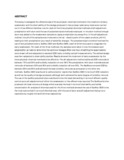| dc.description.abstract | This study investigated the effectiveness of three physical- chemical methods in the treatment of dairy wastewater and the drainability of the sludge produced in the process. Laboratory tests were carried out in three different batches, one for each of the three physical-chemical methods of pH adjustment, precipitation with alum and the use of polyelectrolytes methods employed. In the alum method enough alum was added to the wastewater samples to cause precipitation by sweep floc. In the pH adjustment method, the pH of the samples were lowered to the iso - electric point of the casein proteins, pH 4.5, leading to their precipitation as a result of solubility changes. The polyelectrolytes method involved the use of two polyelectrolytes, Sudfloc 3820 and Sudfloc 3860, each of which was used to coagulate the dairy wastewater. For each of the three methods, the samples were taken in one litre beakers and subjected to Jar tests to determine the optimum dosages After one hour of settling the supernatants were drawn off and subjected to stardard COD tests, turbidity and pH measurements. The settled sludge was then subjected to drainability studies.
Results showed the treatment of dairy wastewater by the three physical- chemical methods to be effective. The pH adjustment method achieved COD removals of between 70% and 90% and turbidity reduction of over 90% The precipitation with alum method acieved removals of between 65% and 85% and turbidity reduction of over 90%. The Sudflocs removed COD by between 60% and 85% and achieved the best turbidity removals as compared to the other two methods. Sudfloc 3820 was found to achieve better results than Sudfloc 3860 in terms of COD reduction as well as the quality of sludge produced, although both achieved the same degree of turbidity removal. The use of the sudfloc polyelectrolytes was found to be the least demanding in terms of effluent quality control as no pH adjustments of either the wastewater or the effluent was required The Sudflocs further produced the least volumes of sludge which was also the best in terms of drainability and solids concentration An analysis of chemical costs for the three methods showed the use of Sudfloc 3820 to be the most economical in terms of chemical cost, with the use of alum and pH-adjustment being more expensive by roughly 4.6 and 8.8 times respectively | en |

